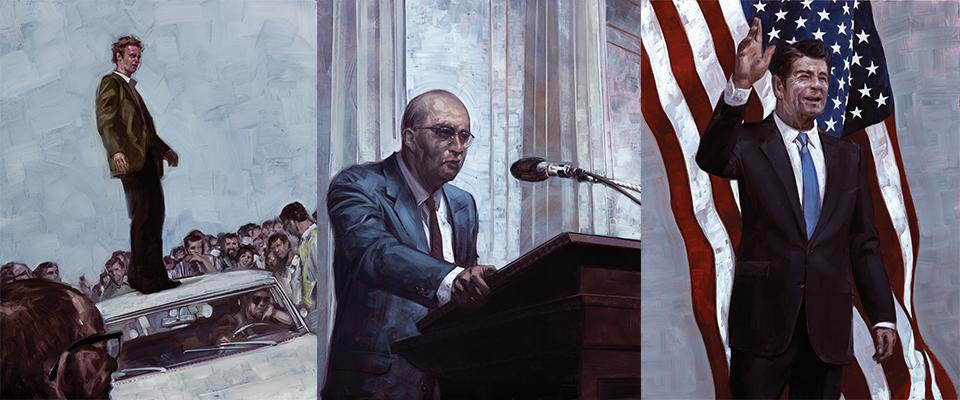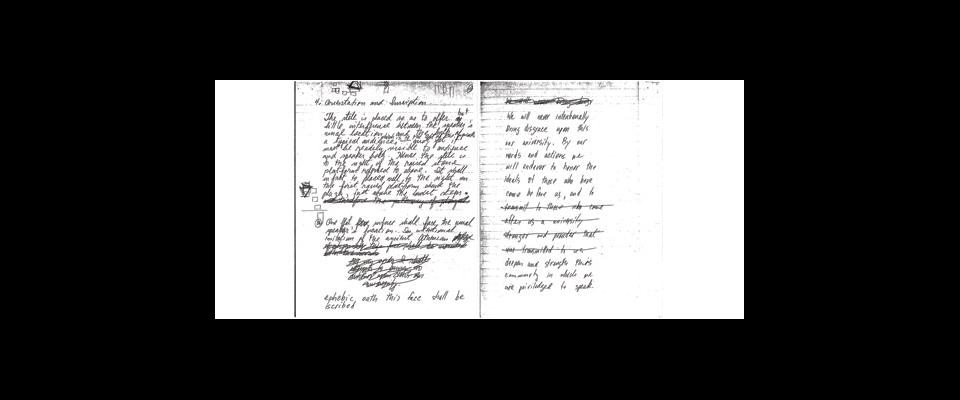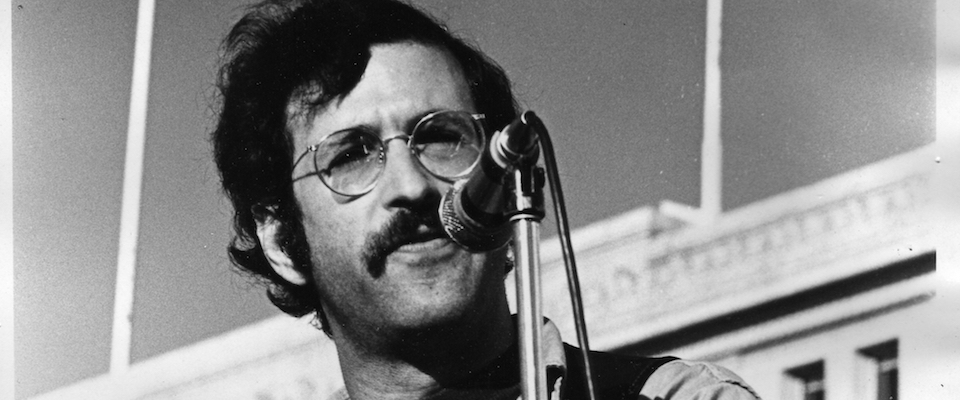Fifty years ago this October 1, thousands of UC Berkeley students spontaneously sat down around a police car on Sproul Plaza and held it captive for 33 hours in protest of a University rule against political activity on campus. Over the next three months, the Free Speech Movement, as it became known, led a series of demonstrations that convulsed the campus and defeated the ban.
A direct outgrowth of the Civil Rights movement, the FSM was the first major campus revolt of the ’60s by white middle-class students, the nonviolent beginning to a decade of generational rebellion. It contributed to a reshaping of national politics. And it planted the University at the center of sometimes pitched battles over fundamental public policy.
The current Berkeley administration has joined in the celebration of the Free Speech Movement’s golden anniversary with a series of officially sponsored events. A dedicated University website proudly declares, “Activism is in our DNA.” The site features a quote by Chancellor Nicholas Dirks, who came to Berkeley from Columbia, another campus with a long history of student activism, last year:
True free speech rejects homogeneity and uniformity, and embraces engagement across differences of background and perspective, with respect for others and disdain for cynicism.
Gentle words, and true. But as evidenced by the University’s handling of more recent protests—notably, the police’s use of force against nonviolent Occupy protesters on Sproul Plaza in November 2011, and the pepper spraying of passive student demonstrators at UC Davis the same month—these matters are more difficult in the event. The FSM itself was a vigorous exercise of First Amendment rights: Students captured a police car and held it hostage on campus. They occupied Sproul Hall. They disrupted a campuswide meeting called by the University president. Hundreds of students were arrested, prosecuted, and convicted. The chancellor was retired, the president fired. There were great public outrage and substantial negative publicity for the institution. Politicians made the University their constant whipping boy. Such are the potential results of campus protest.
The FSM’s legacies are personified by three men central to the conflict: student leader Mario Savio, UC President Clark Kerr, and politician Ronald Reagan—each a radical bent on changing the world.
Savio, the undergraduate in philosophy who was the first to mount the police car that warm fall morning of October 1, 1964, embodies perhaps better than anyone the early 1960s student movement’s fight for a voice. Born in 1942, the year after the United States entered World War II, he was a vessel into which poured the conflicting currents of postwar America. Both parents were of Italian descent and he was the first Savio child born in the United States. The family were devoutly Catholic; Mario was an altar boy, sure that he would grow up to enter the priesthood. He was also exceptionally bright and excelled in science at a public high school in Queens, NY, which he entered the year the Soviets launched Sputnik.
After his civil rights work, Savio felt he would be a “Judas” if he did not challenge the ban on speech.
Savio had been a true believer, but in high school he was increasingly roiled by internal doubts. The valedictorian silently wondered whether classroom duck-and-cover exercises would save anyone in the event of nuclear attack. He began to doubt that the Bible stories he’d been taught were historical fact. Applying scientific skepticism more broadly, he asked how so many people could have stood by during the Holocaust—he deduced that they must have known what was happening. He also struggled to relate to his domineering father. Savio developed an explosive stutter, his eyes rolling and saliva spraying as he struggled to speak.
By college, Savio had broken with the Church, but he’d internalized its essential mission of doing good in the world. He found his cause in the Civil Rights movement, then confronting the manifest injustice of racial inequality in America. He read about student activists at Berkeley, and decided they were doing something “real” and that this was the “place to be.”
Arriving as a sophomore in Fall 1963, Savio became involved with the small Civil Rights community. His first arrest came the following March during the mass sit-in at San Francisco’s Sheraton Palace Hotel, which pressured the city’s hotels to hire more blacks. A few months later, Savio went south for the Mississippi Freedom Summer, along with hundreds of northern white students, to challenge discrimination with voter registration drives and Freedom Schools. Going door to door, he urged people to register in the face of a violent establishment. The Freedom Houses he stayed at received bomb threats. He was beaten by a Klansmen. In 1964, Goodman, Schwerner, and Chaney were murdered.
Savio returned to Berkeley that fall to find campus officials enforcing a University ban on students using the campus to advocate for off-campus political action. The ban dated back to the 1930s. It was hoped that by keeping the University out of politics, politicians would not meddle in campus affairs. By order of Vice Chancellor Alex Sherriffs—who, as I later discovered, was a secret informer in the FBI’s massive surveillance of the campus community—the prohibition was now being applied to students who set up card tables and leafleted for various causes along the “Bancroft Strip,” the brick area at the Telegraph Avenue entrance to campus. For years, students had been allowed to advocate there, on the assumption that the strip was city property and therefore not subject to the ban. Sherriffs determined otherwise.
Savio and other students saw the crackdown as a violation of their constitutional right of free speech and an attack on the Civil Rights movement. Recalling the people he had urged to register to vote in Mississippi, Savio felt he would be a “Judas” if he did not challenge the ban.
“The University is not engaged in making ideas safe for students,” Kerr famously said. “It is engaged in making students safe for ideas.”
The man the students saw as their chief enemy was UC President Clark Kerr. Named the first chancellor of Berkeley in 1952 and president of the statewide University system in 1958, Kerr was an unlikely villain. A man who believed that universal access to higher education was crucial to individual growth, critical to America’s place in the world, and a matter of national security, Kerr oversaw adoption of the state’s 1960 Master Plan for Higher Education. He had first come to Berkeley in the 1930s as a graduate student transferring from Stanford, believing that Cal was more involved in the real world.
By the fall of 1964, Kerr was nationally known as a champion of academic freedom. In one of his early acts as president, he had eased the 1930s ban on political speech so that candidates for public office could speak on campus instead of from podiums set up across the street. In 1960 he had declined to punish students for participating in off-campus protests. In 1963 he convinced the regents to lift the ban on Communist speakers on campus. “The University is not engaged in making ideas safe for students,” Kerr famously said. “It is engaged in making students safe for ideas.”
Kerr in fact saw Sherriffs’s enforcement of the ban on political speech in the fall of 1964 as a “huge mistake,” and advised Berkeley Chancellor Ed Strong to rescind the order. Strong refused, however, and Kerr did not override him, a decision he later said he regretted.
Meanwhile, Savio and other students negotiated with campus officials to no avail. On October 1, Jack Weinberg of the Congress of Racial Equality defiantly set up a table in front of Sproul Hall. When campus police drove onto the middle of the plaza to arrest him—a serious tactical error—students surrounded the cruiser. Photos of the captive car made newspapers everywhere.
After a 33-hour stalemate, Kerr and the protesters agreed to a truce and the students released the car. In the next days, the demonstrators named themselves the Free Speech Movement. The FSM set up an executive committee of more than 50, with representatives of campus groups ranging from the Young Socialists to the Young Republicans. A steering committee of 11 handled day-to-day decisions. But the FSM was based on mass meetings and consensus.
It was also “nonexclusionary”—anyone could join, as long as they supported the main cause. And the FSM attracted broad support, in good part because the movement was seen as a protest against an indifferent University bureaucracy. As recalled by Mona Hutchins, a member of the campus Young Republicans, “People who had felt stifled for a long time and who were tired of standing in long lines and being handed green, pink, and orange forms … every time [they] wanted to get something done, were coming out. There wasn’t any turning back.”
When negotiations with the administration failed, FSM members marched to a regents’ meeting at University Hall but were denied permission to speak. Instead, the regents agreed to allow limited political advocacy on campus. With that concession and the upcoming Thanksgiving break, the FSM lost momentum. But in another misstep, Strong issued new disciplinary charges against Savio and other FSM leaders for the police car protest. Word of their being singled out (and a story alleging that the FSM was a Communist plot, which the FBI planted in the San Francisco Examiner) reignited the movement.
On December 2, the FSM rallied on Sproul Plaza. Savio had emerged as the FSM’s most prominent spokesperson, and though he still stammered in conversation, his words flowed as he delivered his most famous speech:
There’s a time when the operation of the machine becomes so odious, makes you so sick at heart, that you can’t take part. You can’t even passively take part. And you’ve got to put your bodies upon the gears and upon the wheels, upon the levers, upon all the apparatus, and you’ve got to make it stop. And you’ve got to indicate to the people who run it, to the people who own it, that unless you’re free the machine will be prevented from working at all!
After the speech, more than a thousand people filed slowly into Sproul Hall and occupied all four floors. Inside, Savio assailed the “greatest problem of our nation—depersonalized, unresponsive bureaucracy” as the root cause of both the oppression of students at Berkeley and blacks in Mississippi. Meanwhile, Kerr conferred with Governor Edmund G. “Pat” Brown, and they agreed to take no action overnight, giving protesters a chance to leave with impunity. But hours later Brown changed his mind, and the largest mass arrest in decades was witnessed by students arriving on campus the next morning, further energizing the FSM. Nearly half of all students reportedly boycotted classes in protest.
On December 7, Kerr called a campuswide meeting at the Greek Theatre, where he proposed a settlement that further eased the ban but stopped short of rescinding it. Just as Kerr finished speaking, Savio, in suit and tie, strode to the podium. He already had been denied permission to speak, and police officers grabbed him by the throat and dragged him to the ground as the packed theater let out a collective gasp. Kerr, too, was shocked. After the crowd chanted, “Let him speak!” Savio eventually was allowed to return to the stage and say a few words. But the officers’ excessive force angered many, and the next day the Academic Senate voted to back the FSM’s demand to repeal the ban. A few weeks later, the regents conceded that students had full constitutional rights on campus.
“Will we allow a great University to be brought to its knees by a noisy, dissident minority?” Reagan asked. “Will we meet their neurotic vulgarities with vacillation and weakness?”
The FSM’s victory opened the door to all kinds of campus advocacy. The New Yorker writer Calvin Trillin visited Berkeley that winter and reported that “the leaders of the Free Speech Movement find themselves in a perhaps unexpected position—that of revolutionaries whose revolution has succeeded.” The following spring, the campus held one of the nation’s first and largest teach-ins against the Vietnam War. Out of this came the Berkeley-based Vietnam Day Committee, which led massive antiwar marches and tried to block troop trains passing through the city.
By late 1965, Reagan was considering a run for governor the following year. He had come to California to be an actor, but in Hollywood he became president of the Screen Actors Guild and an FBI informer, sometimes naming fellow actors on the scantiest of evidence. From 1954 to 1962, Reagan was a spokesman for General Electric, a “corporate ambassador” speaking to employees and the public. Reagan’s talks gradually became more political, more anti–Big Government, evolving into “The Speech,” his famous 1964 pitch for Republican presidential candidate Barry Goldwater. Like Savio’s orations that fall at Berkeley, Reagan’s address was an impassioned dissent against what he saw as a complacent, if not morally corrupt, status quo. Like Savio, Reagan attacked bureaucracy, elitism, and the loss of individual freedom. But while Savio’s dissent stemmed from civil rights, Reagan’s was based on what he saw as government intrusion on the free market.
As Reagan tested the political waters with appearances around the state, people brought up the trouble at Berkeley. It quickly became his hottest campaign issue. Many citizens, more accustomed to the campus complacency of the ’50s, had been shocked by the student protests, and Reagan deftly tapped into their anger and resentment to attack the incumbent Brown.
When Reagan formally entered the governor’s race in January 1966, he challenged Californians:
Will we allow a great University to be brought to its knees by a noisy, dissident minority? Will we meet their neurotic vulgarities with vacillation and weakness? Or will we tell those entrusted with administering the University we expect them to enforce a code based on decency, common sense, and dedication to the high and noble purpose of the University?
At the National Press Club in Washington, D.C., Reagan belittled Brown’s call for advances in higher education—the governor had called it a “space-age education for a space-age generation”—cracking, “If he means some of the goings-on at Berkeley are ‘way out,’ no argument.” Reagan later claimed, erroneously, that applications to Berkeley had decreased. When University officials said they were actually on the rise, Reagan countered that it was only because the school had lowered standards.
Such rhetoric bothered even H. R. Haldeman, a regent who later became President Nixon’s chief of staff and was convicted for his role in the Watergate scandal. Haldeman suggested to one of Reagan’s advisors that he tone it down. “I didn’t want to see it demagogued with a phony issue, and I knew in a general sense that Reagan didn’t know much about the University and that nobody around him knew much about the University,” he recalled in an oral history.
In November, Reagan defeated Brown by nearly 1 million votes, leading a Republican sweep that left the California Democratic Party a wreck, spearheaded a conservative resurgence, and instantly made Reagan a national political figure. In one of his first acts as governor, he requested a private FBI briefing on Kerr and the protests at Berkeley.
Kerr was fired several weeks later at the first regents’ meeting attended by Reagan, whose election had shifted the balance of power on the board. Brown had refrained from attending most regents’ meetings; Reagan made a point of attending and often held press conferences that turned the meetings into media spectacles. He cut the University’s budget and pushed the regents to impose fees that were, in effect, the first tuition in the school’s history. Although some cuts and tuition were surely inevitable, Reagan continued to make broad charges of campus misconduct, heightening public outrage, damaging morale on campus, and undermining support for the institution. He complained about “subsidizing intellectual curiosity,” and his auditors suggested the University sell its rare book collection to generate state revenue.
But none of this would quell the unrest at Berkeley. Rather, Reagan’s attacks needlessly tarnished the University’s reputation as an institution and undermined public support for higher education in general.
The FSM established that students have the fundamental right to free speech necessary for participation as full-fledged individuals, and helped inspire the antiwar, ethnic studies, women’s, gay rights, and environmental movements. A half-century later, the FSM stands as a model for nonviolent mass organizations built on transparency and consensus.
Given his success as an orator, Mario Savio may have seemed destined for a career in politics. But though he was periodically involved in political affairs, he apparently lacked the desire or the capacity for compromise that is necessary for elected office; he instead remains a symbol of idealistic student activism.
Clark Kerr’s experience illustrates that even the most enlightened administrators are bound to find themselves caught in the middle. It is easy to embrace the idea of free speech and celebrate its expression from the safe remove of 50 years, but it will always be difficult for bureaucrats to deal with its noisome appearance in the here and now.
Berkeley was late in honoring Savio—only after his fatal heart attack in 1996 at age 53 did officials agree to do so. In 1990, Chancellor Ira Michael Heyman allowed a monument dedicated to free speech, but not to the Free Speech Movement, which he deemed too controversial. In 1997, the administration permitted a small bronze plaque officially recognizing the Sproul steps as the Mario Savio steps. And in 2000, using part of a $3.5 million gift from Steve Silberstein, the University finally named something on campus for the FSM—the Free Speech Movement Café at Moffitt Library.
As fraught as the FSM’s legacy may be, it is right for Berkeley to celebrate, however belatedly, Savio and the FSM. Activism may indeed be part of the institution’s DNA; as long as the University is engaged with the real world, and as long as its students and professors pursue truth, it will generate dissent and offend the status quo. That role is in accord with Cal’s namesake, George Berkeley, the iconoclastic poet and philosopher. Looking to the New World, he wrote:
The Muse, disgusted at an Age and Clime
Barren of every glorious Theme,
In distant Lands now waits a better Time …
Where Men shall not impose for Truth and Sense
The Pedantry of Courts and Schools …
Seth Rosenfeld is a Bay Area journalist and frequent contributor to California. His bestselling book, Subversives: The FBI’s War on Student Radicals, and Reagan’s Rise to Power, is now in paperback.





















